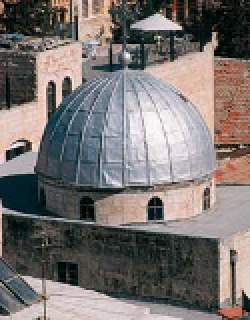Travel Reference
In-Depth Information
Christian Quarter
Road
6
Map
3 B3.
Together with David Street,
which runs from Jaffa Gate
towards the Muristan,
Christian Quarter Road is
one of the main streets in the
Christian Quarter. Marking off
the Muristan zone, it passes
by the western side of the
Holy Sepulchre, and parallel
to Souk Khan el-Zeit. This
busy road is lined with shops
selling antiques, Palestinian
handicrafts (embroidery,
leather goods and Hebron
glass), and religious articles
(icons, carved olive-wood
crucifixes and rosaries).
Midway up the road on the
right, down an alley signpost-
ed for the Holy Sepulchre, a
short stairway descends to the
modest
Omar Mosque
, with
its distinctive square minaret.
Its name commemorates the
caliph Omar, the person
generally credited with saving
the Holy Sepulchre from
falling into Muslim
control after Jerusalem
passed under Muslim
dominion in February
638. Asked to go and
pray inside the church,
which would almost
certainly have meant its
being converted into
a mosque, he instead
prayed on the steps
outside, thus allowing
the church to remain
a Christian site. The
Omar mosque was
built later, in 1193, by
Saladin's son Aphdal
Ali, beside the old Hospital
of the Knights of St John.
The unassuming
Khanqa
Salahiyya
is at the top of
Christian Quarter Road. Built
by Saladin between 1187 and
1189 as a monastery for Sufi
mystics, it is on the site of the
old Crusader Patriarchate of
Jerusalem. Its ornate entrance
way may be as close as you
are allowed, however, as it
is not open to non-Muslims.
Along the north side of the
mosque is El-Khanqa Street.
This attractive, old, stepped
street is lined with interesting
shops, and runs up one of the
Old City's many hills.
The fountain square, at the heart of the Muristan
Church of St John
the Baptist
5
Christian Quarter Rd.
Map
3 C4.
¢
to the public.
headquarters, later building
their own huge hospital to the
north of the church. During
the Crusades it was reported
that there could often be up
to 2,000 people under their
care here at any one time.
By the 16th century the
Muristan had fallen into ruins
and Suleyman the Magnificent
had its stones used to rebuild
Jerusalem's city walls.
Today the Muristan is very
different from how it once
looked, most traces of the
original buildings having long
since disappeared. It is now
characterized by its quiet lanes
and attractive pink-stone
buildings. The lanes converge
at the ornate fountain in the
main square - site of the orig-
inal hospice. The surrounding
streets are packed with small
shops selling souvenirs, handi-
crafts and antiques. Along the
nearby Muristan Road you
will also find a number of
outdoor cafés where you can
sit and absorb the atmosphere.
The silvery dome of the
Church of St John the Baptist
is clearly visible above the
rooftops of the Muristan, but
the entrance is harder to spot
among the hordes of
people along busy
Christian Quarter Road.
A small doorway leads
A
into a courtyard, which
in turn gives access to
the neighbouring Greek
Orthodox monastery and
the church proper.
Founded in the 5th
century, the Church of
St John the Baptist is
one of the most
ancient churches in
Jerusalem. After falling
into ruin, it was
extensively rebuilt in
the 11th century, and aside
from the two bell towers which
are a later addition, the mod-
ern church is little changed.
In 1099 many Christian
knights who were wounded
during the siege of Jerusalem
were taken care of in this
church. After their recovery
they decided to dedicate
themselves to helping the sick
and protecting the pilgrims
visiting Jerusalem. Founding
the Knights of the Hospital of
St John, they later developed
into the military order of the
Hospitallers and played a key
role in the defence of the
Holy Land
(see pp48-9).
Glassware on
sale on Christian
Quarter Road
The distinctive dome of the Church
of St John the Baptist










